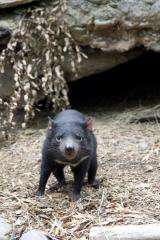Mystery solved: Facial cancer decimating Tasmanian devils likely began in Schwann cells

An international team of scientists led by a Cold Spring Harbor Laboratory (CSHL) investigator has discovered that the deadly facial tumors decimating Australia's Tasmanian devil population probably originated in Schwann cells, a type of tissue that cushions and protects nerve fibers.
The discovery stems from the team's effort to carry out a genetic analysis of tumor cells. Based on these data, the scientists have identified a genetic marker to accurately diagnose the facial cancers, called devil facial tumor disease (DFTD).
The findings, which open new avenues for research into treatments and vaccines, will appear in the journal Science on January 1. Elizabeth Murchison, Ph.D., of CSHL and the Australian National University, is lead author of the paper; the work was conducted with CSHL Professor and HHMI Investigator Greg Hannon, Ph.D., among others.
DFTD is a unique type of cancer that is transmitted from animal to animal via biting or other physical contact - one of only two cancers known to spread by this method, which transfers living cancer cells between individuals (the other cancer is found in dogs). The devils' tumors are mostly found on the face and mouth, but often spread to internal organs. With no diagnostic tests, treatments or vaccines currently available, this aggressive disease could wipe out the Tasmanian devil species in 25 to 35 years.
"Our findings represent a big step forward in the race to save the devils from extinction," says Murchison. The research has provided a method for scientists to distinguish between DFTD and other types of devil cancers. This could be critical in efforts to identify and isolate affected animals and contain the disease's spread.
The team's genetic analysis has confirmed that the tumors that spread from animal to animal are genetically identical - exact clonal copies, each having originated from a single line of cells. The team determined the identity of the originating cell by using advanced sequencing technology to uncover the tumors' "transcriptome" - the complete set of genes that are turned on in tumor cells. Comparing this readout to that from other tissues, the team found that the tumors' genetic signature best matched that of Schwann cells. How these nervous system cells spawned cancer is still a mystery.
"Now that we've taken a good look at the tumors' genetic profile, we can start hunting for genes and pathways involved in tumor formation," says Hannon. The team has also compiled a catalogue of devil genes that might influence the pathology and transmission of the tumor -- information that will be very useful in designing vaccines and other therapeutic strategies.
Provided by Cold Spring Harbor Laboratory





















